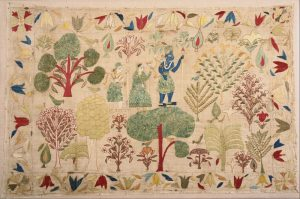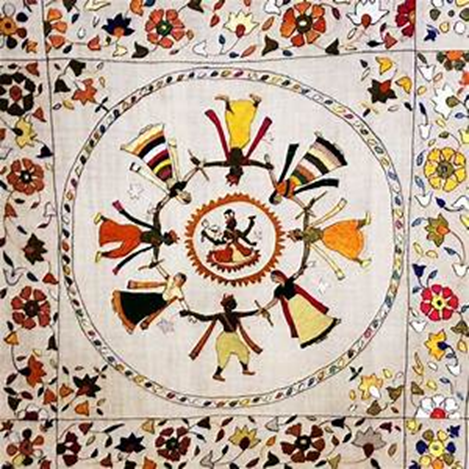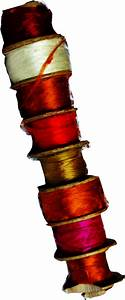By,
Hani Sharma (student)
B.Design (Textile Design)
Satyam Fashion Institute, Noida
The Chamba Rumal is a form of hand embroidery that originated from the Chamba Valley and flourished in the 18th and early 20th century in the mountainous region of North India, especially Himachal Pradesh. Rumal is Persian word which means a ‘Kerchief’, a square piece of cloth worn on the head or around the neck. Traditionally, the Chamba Rumals were embroidered on square pieces of grey fabric. Chamba Rumal has also been called ‘Paintings in Embroidery’ due to the theme being similar to those painted on miniature paintings. The tradition of this kind of pictorial embroidery was known and practical in some areas of Himachal Pradesh and Jammu which remained as the important centers of Pahari paintings.in fig1.1
 Fig1.1: A fine example of Chamba Rumal used as a ceremonial cover
Fig1.1: A fine example of Chamba Rumal used as a ceremonial cover
DESIGN INSPIRATION
This embroidery is mainly done by the women of the upper classes and the designs were based on nature, articles of everyday use and happenings of everyday life, animals, birds and trees etc. that were seen in the surroundings. Also, the designs were depicting mythological scenes from folklores, scriptures and the geometrical designs are very popular too.
COLORS AND FABRICS USED
Colors used were very bright, bold and brilliant. The Pahari style was evolved by the ladies of royalties of Chamba and their attendants which led to the complete development of images similar to the miniatures. Traditionally, the base cloth used was of two types of unbleached cotton cloth, first one being light weight, fine delicate cambric like manufactured in Sialkot, Amritsar, Ludhiana; second being hand-woven, coarser, relatively heavier Khaddar. However, Tussar Silk was also used in white and cream shades being used on festive occasions.
Presently, these handmade cloths are replaced by the mill made cotton cloth. Today, according to the taste, demand, changing fashion trends and rich availability of materials, the ground fabric used can be terecot, organdy, linen, poplin, muslin etc. as shown in fig1.2
 Fig 1.2: Practising Chamba embroidery
Fig 1.2: Practising Chamba embroidery
THREADS USED
The threads used for embroidery were untwisted silk floss or commonly known as ‘Pat’, which gave rich effect against the dull rustic unbleached cotton ground (fig. 1.3). There are some colours used symbolically to represent certain motifs like see in case of Krishna where Blue is always used for the body. Also, red, blue and white colors are used for the Brahma, Vishnu and Mahesh.
Gopi (as in Krishna Ras Leela) were seen in vivid colors of yellow and green or dark pink or crimson combination. The outlines are always worked with black.
 Fig 1.3: Thread used
Fig 1.3: Thread used
STITCHES
The embroidery is primarily done with double satin stitch. The background is hardly visible but, it is very difficult to identify the right side. It was also observed that in some of the old wall hangings, chain stitch was used for outlining as well as filling the motifs. Chain stitch was not seen on the Rumals though. As a later addition, sometimes females even used darning or herring bone in their creations.
MOTIFS AND MAIN THEMES
A greater population of Himachal Pradesh is comprising of Vaishnavas, believers of Lord Krishna, the reincarnation of Lord Vishnu. The Motifs are collectively brought from the life of Lord Krishna. Motifs in Chamba embroidery consists of symbolic animals like leaping tigers, running goat, cantering horses, fleeting rams, jumping deer etc. The bird motifs like peacock, sparrow or parrots are seem quite frequently. Typically, the rumals was designed as an elliptical framework having two to three inches of floral borders on all four sides. The central part has motifs of animals, birds, trees creepers etc.
The common themes seen in Chamba rumals are as follows:
RASAMANDALA: this theme depicts the stories about Lord Krishna and Radha together. (Fig. 1.4)
KALIYA DAMANA: this theme depicts the stories of Lord Krishna slaying the Kaliya sarpa (a vile snake).
RUKMINI HARANA: this theme depicts the stories of the incidents related to Rukmani’s wedding.
RAGA RAGNI: this theme depicts the 4 ragas
ASHTA NAYAK: this theme depicts the mood swings of the remlationship between a male and a female.
MINJAR MELA JALUS: this theme depicts the famous Minjar Mela (a famous fair in Chamba district)
 Fig1.4 Rasa Leela embroidery on a chamba rumal
Fig1.4 Rasa Leela embroidery on a chamba rumal
The breathtaking views of Chamba valley have been popular among the travelers in India and so are its famous crafts like Chamba Rumals. These rumals are made with such love and devotion that it resembles the lyrical movements of Pahari miniature paintings depicted with this precise needle craft.
Key words: Chamba, Hand Embroidery, Pahari Paintings, untwisted silk, Double satin stitch.
REFERENCE:-
https://www.utsavpedia.com/motifs-embroideries/chamba-rumal/
https://asiainch.org/craft/chamba-rumal-embroidery-of-himachal-pradesh
Image Credits:
https://www.worldartcommunity.com/blog/2020/03/following-the-chamba-rumal-craft-trail/
https://brindasuri.blogspot.com/2010/03/chamba-rumal.html